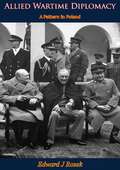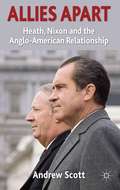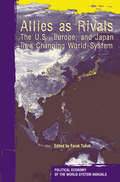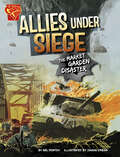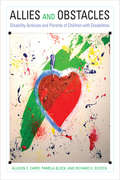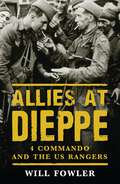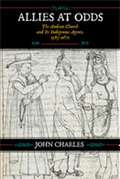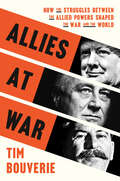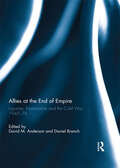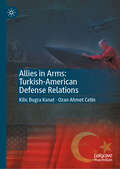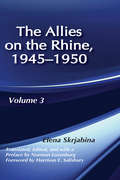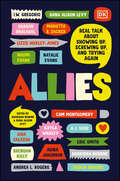- Table View
- List View
Allied Victory Over Japan 1945 (Images of War)
by Jon Diamond"Jon Diamond is to be commended for his attention to detail, great use of maps and amazing photographs." — IPMS/USA In 1944 with the war in Europe turning in the Allies’ favor, Japan still occupied vast swathes of South East Asia and the Pacific. In Burma, the seemly unstoppable Japanese advance was halted at Kohima and Imphal in June and July 1944. Six months later the advances made by British-led forces enabled the re-opening of the supply routes from India to US forces in China. It was not until Spring 1945 that British-led forces seized first Mandalay and then the port city of Rangoon after a year of grueling fighting. Admiral Nimitz’s and General MacArthur’s forces meanwhile were overcoming fanatical Japanese resistance as they invaded Saipan, Guam, Tinian, Leyte and Luzon in late 1944. Iwo Jima and Okinawa fell to the Allies in early 1945. These successes enabled USAAF Superfortresses to bomb mainland Japan. Late Spring/early Summer 1945 saw the steady recapture of the Northern Solomons and Brunei, Borneo and former Dutch colonies. The Soviets were advancing into Manchuria and Korea. The atomic bomb attacks on Hiroshima and Nagasaki in August 1945 finally forced the Japanese to surrender without the inevitable carnage of an invasion of their mainland. The tumultuous events of the final year of the Second World War in the Far East are brilliantly described here in contemporary well captioned images and succinct text.
Allied Wartime Diplomacy: A Pattern In Poland
by Edward J RozekOriginally published in 1959, this volume is a symposium from Official Government documents, Mikolajczyk's private files and other Polish sources is an indictment of Soviet policy towards Poland and of the Western Allies' leniency towards Stalin.
Allied Wartime Diplomacy: A Pattern in Poland
by Edward J RozekOriginally published in 1959, this volume is a symposium from Official Government documents, Mikolajczyk's private files and other Polish sources is an indictment of Soviet policy towards Poland and of the Western Allies' leniency towards Stalin.-Print ed.“This study of one of the most important and most neglected aspects of American foreign policy leading up to the concluding phases of the war and the peace settlements might have been called, in a spirit of bitterness, “The Betrayal of Poland.”…It is a prime piece of documentation and analysis for all who would probe the brutal reality of Soviet policy, neither a riddle nor an enigma to those with eyes to see.The story it tells is, of course, written to show the London Polish government’s efforts to win and keep Polish freedom. Taken largely from the indicated Polish sources, set in their proper context, this work sketches the historical background and traces Soviet policy with great insight. But these sources...make available in a form not previously accessible to the student and scholar the twisting and turning of both British and American policy. This policy, taken up at the crucial points of 1939 and 1944 especially, was confronted by the dilemma of how to honor the British commitments to Poland without laying down a direct challenge to the declared intentions of the Soviet Union. These commitments included not only those given at the outbreak of the war in 1939 but the assurances given at the time of the invasion of Poland by the Soviet Union in 1941 that Britain would not recognize “any territorial changes which have been effected in Poland since Aug., 1939.” The puppet “Lublin government” of handpicked and Communist-controlled figures was intended, as the Moscow broadcasts flatly declared, to assure that “the London clique will be wiped out.” By being forced into a coalition with the Lublin government, the London government-in-exile was indeed wiped out, and Mikolajczyk barely escaped with his life.”
Allied and Axis Signals Intelligence in World War II (Studies in Intelligence)
by David AlvarezThe importance of codebreaking and signals intelligence in the diplomacy and military operations of World War II is reflected in this study of the cryptanalysts, not only of the US and Britain, but all the Allies. The codebreaking war was a global conflict in which many countries were active. The contributions reveal that, for the Axis as well as the Allies, success in the signals war often depended upon close collaboration among alliance partners.
Allies Apart
by Andrew ScottTo date, the Heath-Nixon years have been widely portrayed as marking a low-point in the history of Anglo-American relations even the end of the 'special relationship'; using a wealth of archival material on both sides of the Atlantic, and examining a range of global developments, Allies Apart offers a fresh interpretation of this pivotal period. "
Allies As Rivals: The U.S., Europe and Japan in a Changing World-system (Political Economy of the World-System Annuals)
by Faruk TabakThis book traces the dynamics of international rivalry from the late 1970s up through the present. Among the members of the dominant North political discord has become prominent recently in debates ranging from the Balkan Wars to the Second Gulf War. Yet a wide array of disputes--launching of global positioning systems to steel imports--have shattered the semblance of unity and cooperation among the members of the North, the triad of Europe, U.S., and east Asia. The book explores the subversive ways in which the configuration of economic networks in east Asia are subtly leaving their mark on the structure of the world-system. Also addressed are the ramifications on the South of this sharpening rivalry and, more importantly, whether this round of imperial rivalry will eventually give way, as previously in history, to new forms of international domination.
Allies Under Siege
by Nel YomtovOn September 17, 1944, Allied forces launched Operation Market Garden. This daring offensive behind enemy lines was intended to bring an early end to the war in Europe. But the mission didn’t go as planned and more than 16,000 Allied soldiers were killed, wounded, or captured. What went wrong to turn this bold plan into a horrible disaster, and what was its impact on the war? Young readers will find out in a dramatic graphic novel that tells the tale of one of World War II’s worst military disasters.
Allies and Advocates: Creating an Inclusive and Equitable Culture
by Amber CabralLearn to create an inclusive environment with this actionable and insightful resource Allies and Advocates: Creating an Inclusive and Equitable Culture delivers a powerful and useful message about inclusion and diversity in everyday life. Author Amber Cabral, a celebrated inclusion strategist, speaker, and writer, shows readers how to move away from discriminatory and unjust behaviors to supporting and building meaningful connections with people across our diverse backgrounds and identities. While some books settle for vague advice and catchphrases, readers of Allies and Advocates will benefit from the book’s: Straightforward style and applicable action items Real-world examples highlighting inclusion best practices Implementable tactics to assist people in seeing how they can help create an inclusive environment Perfect for anyone who works in a professional environment, Allies and Advocates is especially useful for those in middle and upper management and those involved in the training and orientation of employees. If you are looking forward to building a culture of inclusivity at work or in your personal relationships, and want to learn how to use your privilege to be a better ally, Allies and Advocates: Creating an Inclusive and Equitable Culture is a must-have.
Allies and Italians under Occupation
by Isobel WilliamsUsing original documents, the Allied Occupation of southern Italy, particularly Sicily and Naples, is illustrated by examining crime and unrest by Allied soldiers, deserters, rogue troops and Italian civilians from drunkenness, theft, rape, and murder to riots, demonstrations, black marketeering and prostitution.
Allies and Obstacles: Disability Activism and Parents of Children with Disabilities
by Allison C. Carey Pamela Block Richard ScotchParents of children with disabilities often situate their activism as a means of improving the world for their child. However, some disabled activists perceive parental activism as working against the independence and dignity of people with disabilities. This thorny relationship is at the heart of the groundbreaking Allies and Obstacles. The authors chronicle parents’ path-breaking advocacy in arenas such as the right to education and to liberty via deinstitutionalization as well as how they engaged in legal and political advocacy. Allies and Obstacles provides a macro analysis of parent activism using a social movement perspective to reveal and analyze the complex—and often tense—relationship of parents to disability rights organizations and activism. The authors look at organizational and individual narratives using four case studies that focus on intellectual disability, psychiatric diagnoses, autism, and a broad range of physical disabilities including cerebral palsy and muscular dystrophy. These cases explore the specific ways in which activism developed among parents and people with disabilities, as well as the points of alliance and the key points of contestation. Ultimately, Allies and Obstacles develops new insights into disability activism, policy, and the family.
Allies and Rivals: German-American Exchange and the Rise of the Modern Research University
by Emily J. LevineDuring the nineteenth century, nearly ten thousand Americans traveled to Germany to study in universities renowned for their research and teaching. By the mid-twentieth century, American institutions led the world. How did America become the center of excellence in higher education? And what does that story reveal about who will lead in the twenty-first century? Allies and Rivals is the first history of the ascent of American higher education seen through the lens of German-American exchange. In a series of compelling portraits of such leaders as Wilhelm von Humboldt, Martha Carey Thomas, and W. E. B. Du Bois, Emily J. Levine shows how academic innovators on both sides of the Atlantic competed and collaborated to shape the research university. Even as nations sought world dominance through scholarship, universities retained values apart from politics and economics. Open borders enabled Americans to unite the English college and German PhD to create the modern research university, a hybrid now replicated the world over. In a captivating narrative spanning one hundred years, Levine upends notions of the university as a timeless ideal, restoring the contemporary university to its rightful place in history. In so doing she reveals that innovation in the twentieth century was rooted in international cooperation—a crucial lesson that bears remembering today.
Allies and Rivals: German-American Exchange and the Rise of the Modern Research University
by Emily J. LevineDuring the nineteenth century, nearly ten thousand Americans traveled to Germany to study in universities renowned for their research and teaching. By the mid-twentieth century, American institutions led the world. How did America become the center of excellence in higher education? And what does that story reveal about who will lead in the twenty-first century? Allies and Rivals is the first history of the ascent of American higher education seen through the lens of German-American exchange. In a series of compelling portraits of such leaders as Wilhelm von Humboldt, Martha Carey Thomas, and W. E. B. Du Bois, Emily J. Levine shows how academic innovators on both sides of the Atlantic competed and collaborated to shape the research university. Even as nations sought world dominance through scholarship, universities retained values apart from politics and economics. Open borders enabled Americans to unite the English college and German PhD to create the modern research university, a hybrid now replicated the world over. In a captivating narrative spanning one hundred years, Levine upends notions of the university as a timeless ideal, restoring the contemporary university to its rightful place in history. In so doing she reveals that innovation in the twentieth century was rooted in international cooperation—a crucial lesson that bears remembering today.
Allies at Dieppe: 4 Commando and the US Rangers
by Will Fowlern August 1942, the Allies launched a raid against the German-held port of Dieppe on the French channel coast. It was largely a disaster, with the Canadian forces bearing the brunt of the catastrophe. However, it wasn't all a failure, and history has tended to overlook the role of 4 Commando, who, along with their US Ranger counter-parts, landed and successfully disabled the German guns threatening the rest of the landings. Their actions proved an excellent demonstration of the military adage “train hard, fight easy” and showed the advantage of proper operational planning and brilliant leadership. This controversial raid also included members of the Free French and it was the first time US land forces engaged the Germans on mainland Europe. Set in the context of the Dieppe raid as a whole, Will Fowler studies the contribution of No. 4 Commando and Operation Cauldron, and evaluates how and why they achieved their objectives in this daring Commando raid of World War II.
Allies at Odds: The Andean Church and Its Indigenous Agents, 1583-1671
by John CharlesThe Polemics of Practical Literacy Catechesis in Quechua Mediating with Cords Writing about Clerical Violence Idolatry Through Andean Eyes The Making of a Literate Andean Society
Allies at War: How the Struggles Between the Allied Powers Shaped the War and the World
by Tim BouverieA &“revelatory&” (The Guardian) political history of World War II that opens a window onto the difficulties of holding together the coalition that ultimately defeated Hitler—by the critically acclaimed author of Appeasement&“A fine reassessment of Allied politics and diplomacy during the Second World War: impeccably researched, elegantly written and compellingly argued.&”—The Times (UK) After the fall of France in June 1940, all that stood between Adolf Hitler and total victory was a narrow stretch of water and the defiance of the British people. Desperate for allies, Winston Churchill did everything he could to bring the United States into the conflict, drive the Soviet Union and Nazi Germany apart, and persuade neutral countries to resist German domination.By early 1942, after the German invasion of Russia and the Japanese attack on Pearl Harbor, the British-Soviet-American alliance was in place. Yet it was an improbable and incongruous coalition, divided by ideology and politics and riven with mistrust and deceit. Churchill, Franklin D. Roosevelt, and Joseph Stalin were partners in the fight to defeat Hitler, but they were also rivals who disagreed on strategy, imperialism, and the future of liberated Europe. Only by looking at their areas of conflict, as well as cooperation, are we able to understand the course of the war and world that developed in its aftermath.Allies at War is a fast-paced, narrative history, based on material drawn from more than a hundred archives. Using vivid, firsthand accounts and unpublished diaries, Bouverie invites readers into the rooms where the critical decisions were made and goes beyond the confines of the Grand Alliance to examine, among other topics, the doomed Anglo-French partnership and fractious relations with General Charles de Gaulle and the Free French, and interactions with Poland, Greece, Francoist Spain and neutral Ireland, Yugoslavia, and Nationalist China.Ambitious and compelling, revealing the political drama behind the military events, Allies at War offers a fresh perspective on the Second World War and the origins of the Cold War.
Allies at the End of Empire: Loyalists, Nationalists and the Cold War, 1945-76
by David M. Anderson and Daniel BranchThe wars of decolonization fought by European colonial powers after 1945 had their origins in the fraught history of imperial domination, but were framed and shaped by the emerging politics of the Cold War. In all the counter-insurgencies mounted against armed nationalist risings in this period, the European colonial powers employed locally recruited militias – styled as ‘loyalists’ – to fight their ‘dirty wars’. These loyalist histories have been neglected in the nationalist narratives that have dominated the post-decolonization landscape, and this book offers the first comparative assessment of the role played by these allies at the end of empire. Their experience illuminates the deeper ambiguities of the decolonization story: some loyalists were subjected to vengeful violence at liberation; others actually claimed the victory for themselves and seized control of the emergent state; while others still maintained a role as fighting units into the Cold War. The overlap between the history of decolonization and the emergence of the Cold War is a central theme in the studies presented here. The collection discusses the categorization of these ‘irregular auxiliary’ forces after 1945, and presents seven case studies from five European colonialisms, covering nine former colonies – Portugal (Angola), the Netherlands (Indonesia), France (Algeria), Belgium (Congo) and Britain (Cyprus, Kenya, Aden, South Yemen and Oman). This book was originally published as a special issue of the International History Review.
Allies for Freedom: Blacks on John Brown
by Benjamin Quarles William S. McfeelyJohn Brown is an endlessly fascinating historical figure. Here are two classic studies by a pioneer in African American studies, one about the place of John Brown in African American history, the other about the reasons for the unique esteem in which he has been held by successive generations of blacks. This two-in-one edition features a new introduction by William S. McFeely, author of the Pulitzer Prize-winningGrant: A Biography.
Allies in Arms: Turkish-American Defense Relations
by Kilic Bugra Kanat Ozan Ahmet Cetin&“Allies in Arms: Turkish-American Defense Relations&” offers an examination of the strategic evolution of military cooperation between the United States and Turkey, with a particular focus on the aerospace and defense industry. The book serves as an introductory resource for readers interested in the changing contours of the US-Turkey bilateral relationship. It outlines the early cooperation, moments of strain, and Turkey&’s drive for greater defense self-sufficiency. It illustrates how US military assistance advanced Turkey&’s defense capabilities while creating strategic dependence and vulnerability. The book traces this dynamic through key events, including the 1960s Cyprus crisis, the 1970s US arms embargo, Turkey&’s F-16 industrial partnership, its involvement in the F-35 program, and the acquisition of the Russian S-400 system. It moves beyond historical narrative to assess the current and future international defense ties. In proposing solutions, it calls for a revised bilateral framework that reflects Turkey&’s growing influence.
Allies in Healing
by Laura Davis"But what about me?" "Is it possible to go one day without dealing with the survivor's issues?" "Will we ever make love again?" "Will the survivor love me in the end?" "How do I know if I should throw in the towel?" Based on in-depth interviews and her workshops for partners across the country, Laura Davis offers practical advice and encouragement to all partners-girlfriends, boyfriends, spouses, and lovers-trying to support the survivors in their lives while tending to their own needs along the way. She shows couples how to deepen compassion, improve communication, and develop an understanding of healing as a shared activity. Addressing partners' most important questions, Allies in Healing covers: The Basics-answers common questions about sexual abuse. Allies in Healing-introduces key concepts of working and growing together. My Needs and Feelings-teaches partners to recognize, value, and express their own needs. Dealing with Crisis-includes strategies for handling suicidal feelings, regression, and hopelessness. Intimacy and Communication-offers practical advice on dealing with distancing, control, trust, and fighting. Sex-provides guidelines for coping with flashbacks, lack of desire, differences in sexual needs, and frustration. Family lssues-suggests a range of ideas for interacting with the survivor's family. Partners' Stories-explores the struggles, triumphs, and courage of eight partners.
Allies of Convenience: A Theory of Bargaining in U.S. Foreign Policy
by Evan N. ResnickSince its founding, the United States has allied with unsavory dictatorships to thwart even more urgent security threats. How well has the United States managed such alliances, and what have been their consequences for its national security? In this book, Evan N. Resnick examines the negotiating tables between the United States and its allies of convenience since World War II and sets forth a novel theory of alliance bargaining.Resnick’s neoclassical realist theory explains why U.S. leaders negotiate less effectively with unfriendly autocratic states than with friendly liberal ones. Since policy makers struggle to mobilize domestic support for controversial alliances, they seek to cast those allies in the most benign possible light. Yet this strategy has the perverse result of weakening leverage in intra-alliance disputes. Resnick tests his theory on America’s Cold War era alliances with China, Pakistan, and Iraq. In all three cases, otherwise hardline presidents bargained anemically on such pivotal issues as China’s sales of ballistic missiles, Pakistan’s development of nuclear weapons, and Iraq’s sponsorship of international terrorism. In contrast, U.S. leaders are more inclined to bargain aggressively with democratic allies who do not provoke domestic opposition, as occurred with the United Kingdom during the Korean War. An innovative work on a crucial and timely international relations topic, Allies of Convenience explains why the United States has mismanaged these “deals with the devil”—with deadly consequences.
Allies on the Rhine, 1945-1950
by Elena SkrjabinaIn The Allies on the Rhine Skrjabina describes the coming of the Allies to the Rhineland, the occupation, and the first clear signs of the recovery of war-shattered Germany. She describes what occurred and how it was interpreted at the time by a keen observer who had lived under Soviet, Nazi, American, and French rule. She describes the first chaotic days of the occupation when instead of the calm and peace expected as a remit of the American advance, there was fearful chaos. She shows clearly that as the main allied forces moved on there was no real law and order and that she and the frightened populace were often terrorized by marauding youthful former work camp inmates over whom there was no effective control.
Allies or Adversaries
by Jennifer N. BrassGovernments throughout the developing world have witnessed a proliferation of non-governmental, non-profit organizations (NGOs) providing services like education, healthcare and piped drinking water in their territory. In Allies or Adversaries, Jennifer N. Brass explains how these NGOs have changed the nature of service provision, governance, and state development in the early twenty-first century. Analyzing original surveys alongside interviews with public officials, NGOs and citizens, Brass traces street-level government-NGO and state-society relations in rural, town and city settings of Kenya. She examines several case studies of NGOs within Africa in order to demonstrate how the boundary between purely state and non-state actors blurs, resulting in a very slow turn toward more accountable and democratic public service administration. Ideal for scholars, international development practitioners, and students interested in global or international affairs, this detailed analysis provides rich data about NGO-government and citizen-state interactions in an accessible and original manner.
Allies: Real Talk About Showing Up, Screwing Up, And Trying Again
by Dana Alison Levy Shakirah BourneThis book is for everyone. Because we can all be allies.As an ally, you use your power—no matter how big or small—to support others. You learn, and try, and mess up, and try harder. In this collection of true stories, 17 critically acclaimed and bestselling YA authors get real about being an ally, needing an ally, and showing up for friends and strangers. From raw stories of racism and invisible disability to powerful moments of passing the mic, these authors share their truths. They invite you to think about your own experiences and choices and how to be a better ally.There are no easy answers, but this book helps you ask better questions. Self-reflection prompts, resources, journaling ideas, and further reading suggestions help you find out what you can do. Because we&’re all in this together. And we all need allies. A portion of the proceeds from this book goes to supporting charities.
Allies: Why the West had to Remove Saddam
by William ShawcrossThe Cold War certainties that had seemed so fixed in the 20th Century were overturned by the war in Iraq. Saddam Hussein's Republican Guards were the battlefield victims of a brutally quick war of shock and awe. No less shocked and awed were some of America's former allies: "old" Europe, large blocks of the UN, and half the G8 nations suddenly found themselves outside the chain of command and influence. Bush, Blair, and their allies were driven by a new global vision. Their mission, expressed with great moral certainty, has been called imperialist. In fact, it was simply inevitable after 9/11: that terrible event ushered in a new era with new rules. Shawcross shows what the future will hold for Iraq, Israel, and the Middle East, how Western alliances will be changed forever, and demonstrates that the war was the definitive proof that a new era of 21st Century international politics has begun.
Alligator Blood
by James LeightonIn 2003, when an amateur online poker player managed to win the World Series of Poker, millions of people created accounts to try to emulate his success. Thus began online poker's transition from hobby to fully-fledged career for many players, eventually growing to become the multi-billion dollar industry it is today. Along with the amazing success stories, colourful personalities and corporate sponsors came scandal and corruption, as anti-gambling laws shut down many sites while enterprising young upstarts invented new ways to get around them. Among these was Daniel Tzvetkoff, a 26-year-old Australian who set up an online service to disguise gambling revenues as legal payments. His website made him one of the richest people in Australia almost overnight, but his playboy lifestyle was not to last. Faced with lawsuits from all sides, as well as criminal investigations, he struck up a deal with the FBI in order to save his skin, one which would shake the online poker industry to its core.


